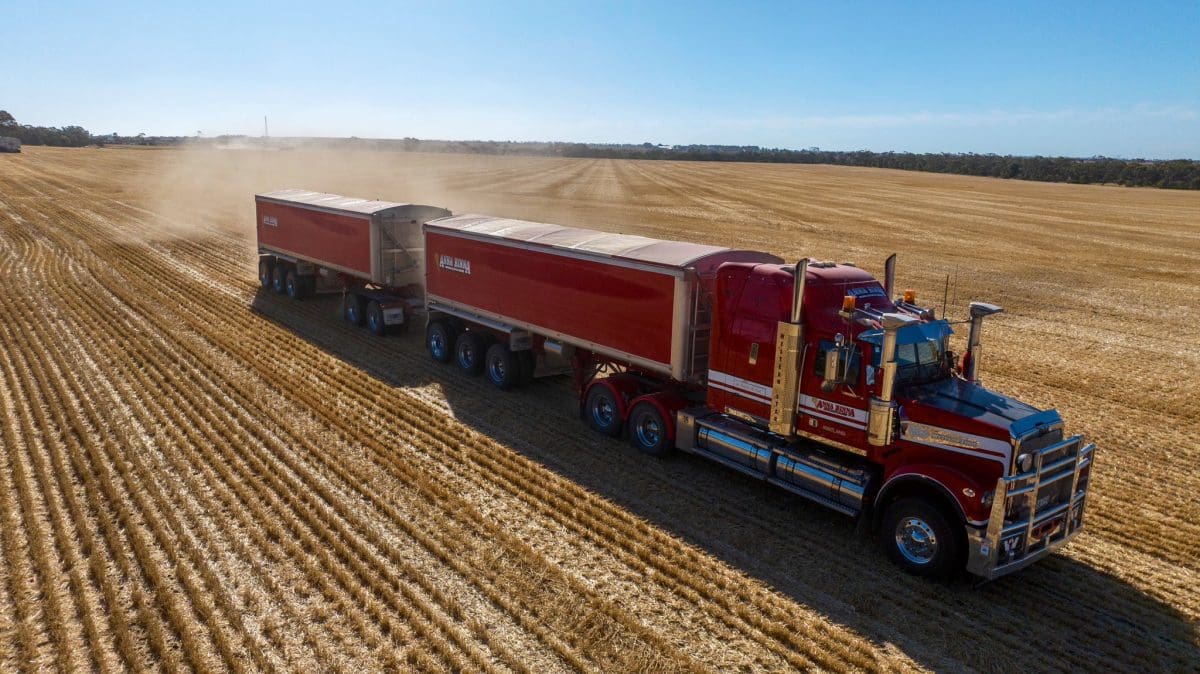
Carting wheat from the harvest which finished at New Year on Anna Binna Farms on South Australia’s Yorke Peninsula. As with many farms in SA, APW rather than H1 was the predominant grade, a function of high yields and rain late in the growing season. Photo: Freddie Gittus
PRICE speads for feedgrains have narrowed in the northern market to reflect buoyant demand for sorghum as dry conditions bring the early crop home at a rapid pace.
In the south, many growers have now finished their wheat and barley harvesting, or are a week or so from completion, and are feeding some tonnage into the market to match steady demand from stockfeed and export buyers.
The firming Australian dollar has tempered export demand for feed wheat and barley, and stockfeed millers continue to use downgraded faba beans at maximum inclusion in their rations to cap nearby demand for white grain.
| Today | Jan 12 | |
| Barley Downs | $405 | $405 |
| SFW wheat Downs | $400 | $408 |
| Sorghum Downs | $405 | $400 |
| Barley Melbourne | $370 | $370 |
| ASW Melbourne | $425 | $420 |
| SFW Melbourne | $415 | $415 |
Table 1: Indicative prices in Australian dollars per tonne.
Mixed outlook in north
Heavy rain across much of northern Australia has extended into Central Queensland in the week to 9am today.
Registrations include: Clermont 154mm; Emerald 104mm, and Springsure 45mm.
This rain is ideal for the planting of CQ sorghum crop, which will take place in coming weeks, weather permitting, for harvest mid year.
However, topsoil in most cropping regions of southern Queensland and northern New South Wales is extremely dry, and clear skies and warm temperatures are bringing the early-sown crop home at speed.
Norco grain manager Ian Handley said the nearby market is now factoring in some early new-crop sorghum.
“Harvest will start within two weeks, and there’ll be a February-March harvest, which is a bit earlier than normal,” Mr Handley said.
“The Downs is having a dry finish, and we feel there isn’t as big a late crop as was expected because that rain to get it planted didn’t turn up for a lot of growers.”
Mr Handley said the SFW wheat market has a softer feel to it as growers look to sell on-farm stocks to make room for sorghum.
F1 feed barley is in solid demand to reflect the grade profile of the 2022-23 harvest.
“A lot of product went into malt, and a lot of barley didn’t have the weight so it went into F2.”
While feedlots have a strong preference for F1 barley, demand from those milling for dairy herds is supporting the F2 market now that much of the F1 has been priced.
Mr Handley said some domestic consumers have coverage as far out as June on white grains, and have largely bypassed sorghum because of its relatively high price.
Harvest nears end in south
Most growers in the Victorian Wimmera and South Australia beyond the South East have finished harvesting cereals, and are offering small parcels of feed barley and ASW and below wheat to the market.
“Things are going mostly sideways; barley’s steady and SFW is steady,” Wilken Grain trader Andrew Kelso said.
Keeping pressure off the lower wheat grades is the quality profile of the harvest, which is generally better than the market was expecting.
“There’s a bit more APW and H2 around than everybody thought.”
Durum also appears to have escaped widespread downgrading to feed, despite the wet end to the growing season.
“The domestic consumer is chipping away and buying bits and pieces, but currency is putting a limit on firmness in the market.”
In Western Australia, CBH Group has ceased its weekly harvest updates ahead of its final harvest report.
In the interim, the co-op advised Grain Central on Tuesday that CBH receivals for the harvest to date totalled 22.2 million tonnes (Mt).
This is up from 21.7Mt received to January 9, and represents deliveries totalling around 500,000t over the eight days, down from 3Mt plus a week during the harvest peak.
Traders have said the average protein of WA’s wheat is low, an expected reflection of its unusually mild and wet growing season, and that east-coast cargoes are therefore up against tough competition from the west on ASW and SFW sales.
Grain Central: Get our free news straight to your inbox – Click here

HAVE YOUR SAY